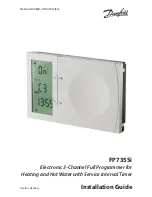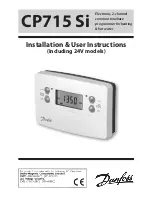
or respectively.
8. TEMPERATURE STORAGE
The LF28 features a system for permanent storage of the minimum and maximum temperature logged during operation. This system is a valid
help to achieve compliance with the HACCP directive in its part relating to a correct preservation of foodstuffs. Temperature is measured by
probe T1 which should therefore be placed in a point where the temperature of the preserved product may always be measured correctly. The
logging is however subject to some simple rules that filter the data and give a rational interpretation. The logging is suspended during the
periods in which the refrigerator is put on a standby and during defrostings and, during the normal operation (thermostatic control), it’s “slowed
down” through the parameter
TLD
. This parameter defines the time during which the measured temperature must permanently exceed the
current value before the logging is performed. In this way, it will be possible to avoid idle loggings that don’t reflect the actual product
temperature, for example, the door remaining open for a short period of time, the temperature recovery after a defrost or other temporary
short term temperature huntings.
It is suggested that a reasonably long TLD time is programmed, for instance 5-15 minutes, you then put the product into the refrigerator and
start a new logging cycle by clearing previous values (see par. 2.3). It will now suffice that at regular intervals, in the INFO menu you check
the minimum and maximum logged values in order to know if the product has been kept within the required temperature limits.
9. AUXILIARY FUNCTIONS
9.1
In addition to the basic functions described above, the LF28 offers an innovative feature to enhance the performance of the
refrigerator. Infact, you can select the control parameters between two different pre-programmed groups, in order for the fundamental
control parameters to be adapted quickly to changing needs such as, for example: High/Low Temperature range change, day/night
operation stored, product change (meat, fish, vegetables …), maximum cooling capacity or energy saving. The parameters switched over
in mode
I
and
II
are:
SPL
,
SPH
,
SP
,
HYS
,
DFR
,
FTC
and
IISL
,
IISH
,
IISP
,
IIHY
,
IIFT
,
IIDF
.
With the parameter
IISM
you select if the changeover from Group
I
to Group
II
is made manually, via the button
(IISM=MAN), or
automatically when heavy duty operation is detected (IISM=HDD), or when the auxiliary input D12 is activated (IISM=DI2), or inhibited
(IISM=NON). The activation of Group
II
is signalled by the lighting up of the relevant LED on the controller display.
9.2
The automatic detection of “heavy duty operation” allows the control parameters to be modified in response to the specific
temporary needs of the refrigerator, such as: warm food being put into the cabinet, door being opened frequently etc. Control sensitivity
to switch over from Group I to Group II is determined by parameter
HDS
(1=minimum, 5=maximum). An example of how to use such
function is reported in the following table:
If we apply the above example to a refrigerator in a restaurant kitchen the controller will use the parameters of Group I during the closing
times of the kitchen, when the need for cooling is minimum, therefore we can consider this as a “normal” operation condition. Group I
“economy control” parameters will ensure both an optimum foodstuff preservation and considerable energy saving. Alternatively, during
very busy periods (door being opened continuously to take out or load food), the controller will automatically select Group II to try and
maintain the average product temperature within correct values (lower setpoint), limit compressor wear by reducing the number of starts
(higher hysteresis), avoid long defrost pauses which will worsen the preservation condition (lower defrost frequency or no defrosts at all),
increase product cooling speed by keeping ventilation always active (IIFT=NO). When the heavy duty period is over, the controller will
automatically resort back to Group I.
NOTE: To make the automatic detection IISM=HDD work better, it is suggested that the value of hysteresis is not set too narrow (less than
2°K) or the value of CRT is not set too high (longer than 2 minutes).
9.3
if fitted, the auxiliary output can be programmed for the control of the refrigerator lights. Through the parameter
LSM
you select
how the lights are turned on: manually, through the button
(LSM=MAN), or when the door is opened (LSM=DOR). With LSM=NON,
this function is disabled.
9.4
The operation of the auxiliary output, if fitted depending on the model, is controlled through the parameter
OAU
. With OAU=0-
1 the relay contacts follow the on/off status of controller (standby=OFF). With OAU=LGT, the output is used to control the refrigerator
lights (see 9.3).with OAU=2CU the output is programmed to drive the second condensing unit, i.e. an auxiliary compressor which is
piloted in parallel with the main compressor, and its start is delayed by an amount of seconds programmed with the parameter
2CD
;
viceversa, the second compressor stops together with the main compressor. With OAU=2EU the output is enabled for the control of the
electrical defrost of the second evaporator (see par. 5.3) and finally, with OAU=ALR the output is connected to the alarm function, the
contacts are therefore closed during normal operation and open when an alarm condition occurs (reversed operation). With OAU=NON
the contacts remain open constantly.
P
ARAMETER
G
ROUP
I
G
ROUP
II
setpoint
SP=-18
IISP=-21
Hysteresis
HYS= 2.0
IIHY= 3.0
Defrost frequency
DFR= 3
IIDF= 1.. 0
intermitt. fans
FTC= YES
IIFT= NO
INSTRUCTIONS FOR INSTALLATION AND USE.

























